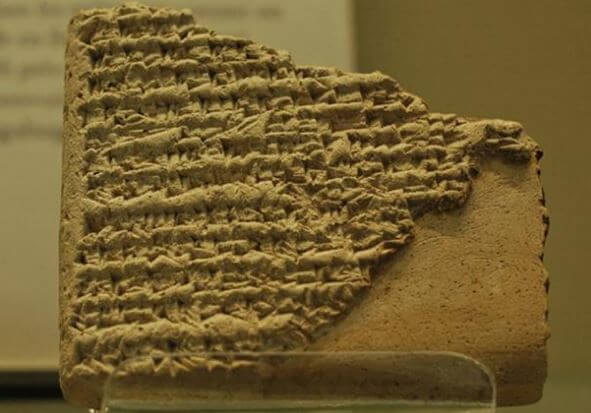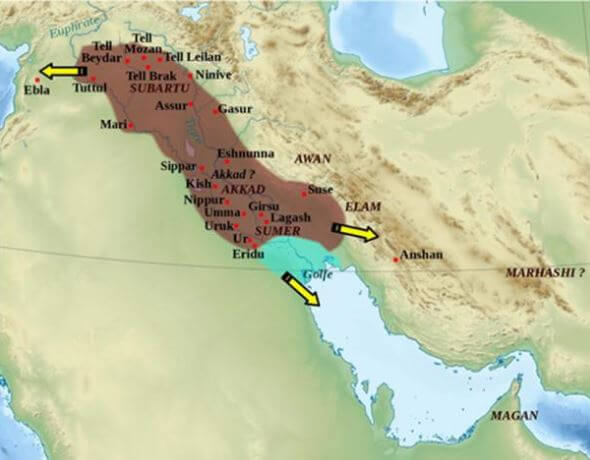 1
1

Arkaim and the texts of Rgveda about his builders
 25. 04. 2024
25. 04. 2024



 03. 06. 2021
03. 06. 2021

The Akkadian Empire was an ancient state entity whose existence dates back to the end of the 3rd millennium BC. It was the first empire in Mesopotamia, and some consider it to be the first real empire in world history. The Akkadian Empire was founded by Sargon of Akkadian, probably its most famous ruler, and Mesopotamia dominated from its capital Akkad. The influence of the Akkadian Empire was felt beyond the borders of the empire. However, its duration was not very long, as it collapsed about one and a half centuries after it was founded.
The period of Mesopotamian history, preceding the founding of the Akkadian Empire, is described by archaeologists as an early dynastic period that lasted from about 2900 to 2350 BC. During the early dynasty, urban states, including the cities of Ur, Uruk, Lagash, and Kish, rose in southern Mesopotamia. The political situation at the time was fragmented and city-states often fought against each other. On the other hand, material knowledge from various establishments shows that they were culturally homogeneous. While the Sumerians ruled southern Mesopotamia, the Akkadians dominated northern Mesopotamia. Like the Sumerians, the Akkadian established their own city-states to fight against each other.
With the advent of the Akkadian Empire, the situation in Mesopotamia changed during the 24th century BC. Thanks to the Akkadian Empire, the Sumerians in southern Mesopotamia and the Akkadian in northern Mesopotamia were united under one government for the first time in the region's history. The man responsible for this unification was Sargon of Akkadian, who is considered one of the first empire builders in the world.
Historically, very little is known about Sargon's life, as no contemporary documentary evidence is lacking. This is partly due to the fact that Akkad, the capital of the Akkadian Empire, has not yet been found. Any records that have been written and stored in it have yet to be discovered. Therefore, in order to obtain information about Sargon's life, scientists have to rely on sources written later. They exist in the form of legends and narratives, which is not surprising given the reputation this great ruler has left for himself.
Legend has it that Sargon was found floating in a basket on the river as a child. He was found by a gardener who adopted him and raised him as his own son. The identity of his real father is unknown, as his mother was said to be a temple prostitute or priestess in a town near the Euphrates. Although Sargon, like his adoptive father, was a simple gardener and had no influential relatives, he managed to get a job as a waiter with the ruler of the city-state of Kish.
According to a legend known as Sargon's legend, this ruler was named Ur-Zababa and Sargon was named his waiter for unknown reasons. The royal waiter was a very important fast at that time, because he brought his holder very close to the monarch and thus became one of his closest and most trusted advisers.

A clay plaque depicting the birth of Sargon, the first ruler of the Akkadian Empire, and his quarrel with King Ur-Zababa of Kish. (Jastrow / Public Domain)
In Sargon's legend, Sargon had a dream in which Ur-Zababa was drowned by a young woman in a great bloody river. The king discussed this dream with Sargon and was incredibly frightened. That's why he made a plan to get rid of Sargon.
He gave Sargon a bronze mirror to deliver to the king's blacksmith, Belic-tikal, in E-sikil. The blacksmith had to throw Sargon into the furnace as soon as he delivered the item and thus kill him. Sargon, unaware of Ur-Zababa's evil conspiracy, followed the king's orders and went to E-sikil. But before he arrived, he was stopped by the goddess Inanna, who told him that E-sikil was a holy place and that no one contaminated with blood was allowed to enter. Sargon therefore met a blacksmith at the city gates to hand over the mirror, and therefore he was not killed.
A few days later, Sargon returned to the king, and Ur-Zababa became even more frightened to see that Sargon was still alive. This time he decided to send Sargon to King Lugal-zage-si of Uruguay with a message telling the king to kill the messenger. The rest of the legend is lost, so the end of the story is unknown. However, it is likely that this is the story of how Sargon became king.
In any case, it is known that Lugal-zage-si was a powerful ruler who united the Sumerian city-states. It is also known that once Sargon came to power, he attacked Lugal-zage-si and defeated him. Once the southern Mesopotamian city-states were defeated, Sargon washed his hands in the "lower sea" (in the Persian Gulf), a symbolic gesture to show that all of Sumer was now under his rule.
However, the conquest of southern Mesopotamia was not enough for Sargon and he continued to expand his empire. He launched military campaigns in the east, during which he defeated Elam, and other rulers of the region surrendered to him. Sargon also pushed the borders of the Akkadian Empire to the west and conquered two states of modern Syria that were constantly fighting for regional supremacy - Mari and Eblu.
One of the consequences of Sargon's conquest was the creation of trade routes. Because all of Mesopotamia was now under Akkadian rule, goods could safely flow from north to south along the Euphrates River. Cedar wood came from Lebanese forests, while precious metal was obtained from mines in the Taurus Mountains. The Akkadian also traded with more distant lands - Anatolia, Magan (probably today's Oman) and even India.
In the Epic of the Battle King, Sargon is said to have launched a military campaign deep into the heart of Anatolia. The alleged campaign was conducted to protect the merchants from the ruler Burushanda, who unfairly exploited them. By the way, the text also claims that Sargon entered the Mediterranean and landed in Cyprus.

Map of the Akkadian Empire and directions in which military campaigns were conducted. (Zunkir / CC BY-SA 3.0)
Sargon ruled from about 2334 BC until his death in about 2279 BC. His successor was Rimush, one of his sons. The second ruler ruled the Akkadian Empire for about 9 years and fought hard to keep it intact. Numerous riots broke out during his reign, but Rimush was able to deal with them successfully.
According to legend, Rimush was assassinated by his own officials. His successor was his older brother Manishtushu. As his brother managed to stabilize the internal affairs of the empire, Manishtushu was able to concentrate his forces on external affairs. In addition to launching military campaigns, he also strengthened trade relations with foreign powers. Like his predecessor, Manishtushu was assassinated by his own officials. The rule of Rimush and Manishtushua is often overlooked in history because it is sandwiched between two of the greatest rulers of the Akkadian Empire, Sargon before them and their successor, Naram-Sina.
Naram-Sin was the fourth ruler of the Akkadian Empire. He was the grandson of Sargon and the son of Manishtush. It was during his reign, which lasted from about 2254 to 2218 BC, that the Akkadian Empire reached its peak. Naram-Sin continued his father and grandfather's military campaigns in areas of western Iran and northern Syria.
Thanks to his successful military expeditions, he won the title of "King of the Four World Parties". In addition, Naram-Sin gained the status of a "living god" and his deification was carried out at the request of the citizens, according to the inscription. The stela, known as Naram-Sin's Triumphal stela (now housed in the Louvre Museum in Paris), depicts a warlord greater than all the surrounding figures, with a horned helmet on his head. Both of these characteristics represent the king's divine position.
In addition to his military victories, Naram-Sin is also known for unifying the empire's financial accounts. By appointing several of his daughters high chief priestesses of important cults in Mesopotamian city-states, he further increased the prestige and religious significance of the Akkadian Empire.

The stele of the Akkadian king Naram-Sina, ruler of the Akkadian empire. (Fui in terra aliena / Public Domain)
After the magnificent rule of Naram-Sina, the Akkadian Empire began to decline. Naram-Sin's son and successor Shar-Kali-Sharri had to deal with external threats, so the Akkadian refocused on defense. Nevertheless, he was still able to maintain control of the empire and prevent its disintegration.
After his death, however, there was apparently a power struggle for the throne. Some of the city-states in southern Mesopotamia took this opportunity to restore their independence, which meant the loss of this territory for the Akkadian. The last two rulers of the Akkadian Empire were Dudu and Shu-Turul. At this time, however, the Akkadian no longer ruled the entire empire, but only the area around their capital.
The demise of the Akkadian Empire occurred around 2150 BC. According to the traditional version, the collapse of the Akkadian Empire was the result of divine retribution. As mentioned earlier, Naram-Sin claimed to be a "living god," which was considered arrogance. Ancient historians considered Naram-Sin's extreme pride to be the cause of the wrath of the gods who sent him to his successor. He came in the form of the Gutians, barbarians from the Zagros Mountains, who invaded the Akkadian Empire and destroyed everything in their path.
Modern scientists have put forward a number of other hypotheses in an effort to explain the causes of the collapse of the First World Empire. Among other things, administrative incompetence, a poor harvest, a provincial uprising or a huge meteorite have been suggested as the cause of the fall of the Akkadian Empire. Recently, blame has also been attributed to climate change, and evidence has even been provided to support this hypothesis.
In 1993, a report was issued that the Akkadian Empire had been hit by a long and severe drought that had caused its demise. Microscopic analyzes of soil moisture collected from Akkadian localities in the north suggest that there has been a severe drought since 2200 BC. This period has lasted 300 years, and scientists believe that this is what destroyed the Akkadian Empire. Signs of a long drought are also visible from archaeologists, who say that several Akkadian cities in the northern plains were abandoned at once. The migration of peoples to the south is also mentioned in clay tablets.
Scientists did not have a clear idea of the cause of the drought, so they mentioned various factors such as changing wind patterns and ocean currents or the massive volcanic eruption in Anatolia at the beginning of this period. The drought hypothesis that Dr. came up with Harvey Weiss University in Yale, has had its supporters and critics over the years. One criticism of this hypothesis is that the data, including sediments from the Red Sea and the Gulf of Oman, which were subsequently evaluated, were simply not accurate enough to confirm a direct link between the drought and the changes that took place in the Akkadian Empire during this period.
A team of scientists led by Dr. Stacy Carolin has recently studied stalagmites from an Iranian cave. Although the cave is located far beyond the eastern border of the Akkadian Empire, it lies directly downwind, which means that most of the dust deposited here could come from the deserts of Syria and Iraq. Based on the fact that the desert dust contains higher amounts of magnesium from the local limestone, which is formed by the stalagmites of the cave, the scientists were able to determine the dustiness of the cave bottom at a certain period. The higher the magnesium concentration, the dustier the soil and the drier the desert conditions. In addition, uranium-thorium chronology made it possible to accurately date stalagmites, which revealed that there were two significant periods of drought, one of which occurred at the time of the collapse of the Akkadian Empire and lasted about 290 years.

Cave stalagmites found in Syria and Iraq help experts study the Akkadian Empire. (micropixel / Adobe)
After the fall of the Akkadian Empire, Mesopotamia was ruled by the Gutians. However, relatively little is known about this period. Around 2100 BC, the Third Ur Dynasty came to power, which meant a transfer of power, after the Akkadian period, back to the Sumerians.
Although the documents of that time were again written in Sumerian, the language itself gradually disappeared. During the Akkadian period, the Sumerian language was replaced by the Akkadian language. Thanks to the Akkadian Empire, the Akkadian language thus became French language The region and its use, albeit in altered forms, were continued by subsequent Mesopotamian civilizations, including the Assyrians and Babylonians.
Systemic, sometimes also known as family constellations are an effective method of looking at what bothers us. Thanks to them, we can see what is happening below the surface, what is not completely obvious at first glance. Whether it is relationships in the family, work, health or directly in ourselves. Constellations are one of the other methods on our way to harmony. Edit Tichá, a craniosacral biodynamics therapist and occasional presenter at the Sueneé Universe, invited Katka Zachová as her guest.
Katka Zachová has been actively involved in systemic constellations for more than 7 years. After training with Bhagata, she began to delve deeper into this therapeutic method and is now helping other people. He leads seminars in the Klid studio at the crossroads in Hradec Králové and is also involved in individual therapeutic practice in Prague.